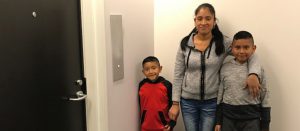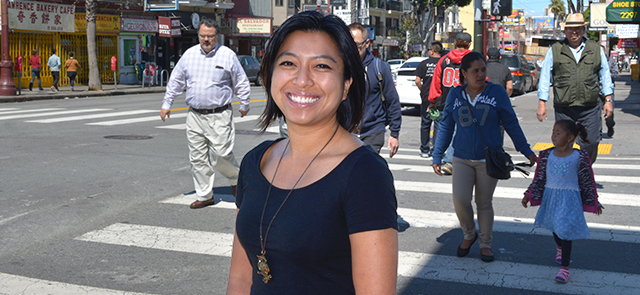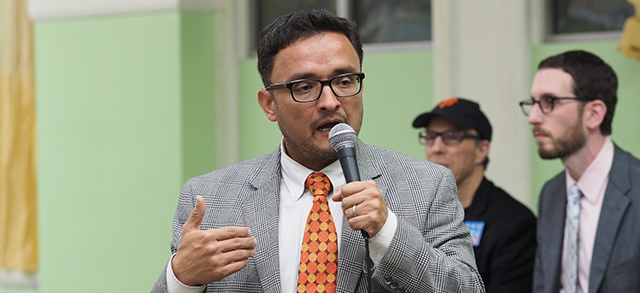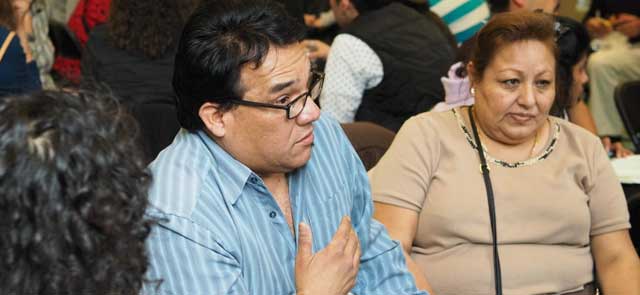por Adriana Jones Lima
(English follows Spanish)
La familia Arriola Hernández vino a los Estados Unidos en los noventas y es originalmente de la Ciudad de México. Refugio llegó primero a los EEUU a continuar sus estudios y luego mandó por su esposa, Elvira. A poco tiempo Refugio aprendió que la vida estadounidense cuesta mucho y se encontró con la necesidad de trabajar por tiempo completo.
Años después, Carmen la hermana de Elvira vino a San Francisco para reunirse con su ella y su esposo, y los tres compartieron un apartamento en 656-48 Capp St. Aquí en San Francisco, Carmen conoció a su esposo Mario Hernández y los dos se movieron a un studio debajo del apartamento de su hermana Elvira.
La familia Arriola le gusta vivir en La Mission por la cultura y se siente muy agusto porque puede hablar su propio lenguaje, y ir de compras en tiendas y supermercados que llevan productos como los que conoce en México. También viven en una locación perfecta, están localizados muy cerca de transporte público y no necesita coche.
Elvira y Refugio tienen dos hijas Gloria y Jessica. Gloria asiste John O’Connell High y Jessica en Cesar Chavez Elementary. Las dos escuelas son parte de La Comunidad Promesa de la Mission. En Cesar Chavez, la familia Arriola conocio a Yadira Diaz (foto, tercer derecha), Guia de Éxito Familiar de la Comunidad Promesa de La Mission. Elvira es una mamá voluntaria. Desde el 2006 Elvira es voluntaria en Cesar Chavez ayudando a las maestras en preparara sus materiales para la clases también es voluntaria en Buena Vista Horace Mann K-8 y John O’Connell High School. También apoya a Diaz cuando ofrece talleres de servicios a los padres. Elvira también es la vice-presidenta de ELAC (English Learners Advisory Council). Jessica y Gloria aprecian mucho a Elvira y les gusta pasar tiempo de calidad con sus mama y recibir su apoyo en la escuela. La familia Arriola Hernandez tiene una gran presencia en la Mission. Refugio, Carmen, y Mario trabajan en limpieza en la ciudad. Carmen también vende sus ricos tamales en el corazón de la Misión, y su esposo le ayuda a prepararlos.
Después de 20 años de vivir en su hogar en la Mission la familia recibió una carta explicando que la dueña iba poner el edificio en venta. La familia Arriola Hernández es testigo del desalojo que está sucediendo en La Mission y tenía miedo que su futuro sería igual a los 8,000 Latinos que han sido desalojado de sus casas desde el 2000. La carta del dueño del edificio llegó como un golpe a la familia, rompiendo su tranquilidad con la realización que tal vez podría ser desalojado de su hogar.
Refugio recuerda ese momento muy difícil, “no podíamos dormir ni comer. Me despertaba cada noche a las 2 o 3 de la mañana pensando en el futuro de mi familia. Pensé que nuestra única opción era volver a México.” El gran miedo de Refugio y Elvira era de quitarles a sus hijas la única casa que conocían y empezar un vida nueva en México.
Elvira confió en Diaz durante ese momento difícil para encontrar una solución. Diaz refirió a la familia al equipo de Bienes Raíces de la Comunidad en MEDA. Después de su primera cita en MEDA la familia Arriola Hernandez empezó a trabajar con MEDA para comprará el edificio donde vivían. La familia organizaron a todos los inquilinos para pedirle a los dueños del edificio que vendieran a MEDA. Después de mucho trabajo escribiendo cartas y haciendo llamadas a los dueños el edificio se le vendió a MEDA, y se formó parte del programa “Small Sites.”
Juan Diego Castro, de MEDA, explicó que la familia tomó la gran responsabilidad de organizar a los inquilinos para que MEDA pudiera comprar el edificio y asegurarse que los inquilinos no fueran desalojados. La familia Arriola Hernandez les daba esperanza a los inquilinos en ese momento difícil y siempre estaban al tanto comunicando los procesos de la venta
Después que MEDA compró el edificio, Refugio todavía recordaba lo sucedido y cómo su edificio tenía un rótulo de venta. Refugio y Castro de MEDA quitaron el anuncio juntos. Al final, Refugio y su familia pudieron dormir sin miedo y pudieron seguir sus vidas. Necesitamos crear más oportunidades para familias como la familia Arriola Hernández en la Misión, esta familia forma un componente importante de nuestra comunidad.
A Determined Family is Strengthened
The Arriola Hernandez family moved to the United States in the 1990s from Mexico City. Refugio Arriola was the first one to move to the U.S., seeking to continue his studies. The newcomer quickly learned that life in his adopted homeland was very expensive, forcing him to spend much of his time working just to keep pace. Once settled, he was reunited with his wife, Elvira, in San Francisco.
A few years later, Elvira’s sister, Carmen, also moved to San Francisco to live with her sister and brother-in-law. The three shared an apartment at 656-48 Capp St. Carmen later met her husband, Mario Hernandez, and the pair moved into a studio on a floor below her sister.
The Arriola family enjoys living in the Mission because of the culture: They feel comfortable here because they have the ability to speak their native language, plus go shopping in stores and supermarkets that carry products found back home in Mexico. Their apartment is in a perfect location, as living within walking distance to public transportation allows them to get around the city without the expense of owning a vehicle.
Elvira and Refugio have two daughters attending Mission Promise Neighborhood schools: Gloria attends John O’Connell High School; and Jessica is a student at Cesar Chavez Elementary School. While volunteering at Cesar Chavez, Elvira met MPN Family Success Coach Yadira Diaz (photo, third right). Looking to give back to her community, Elvira has volunteered at Cesar Chavez elementary school since 2006, helping teachers prepare materials for class, plus supporting Diaz in the connection of families to free services. Additionally, Elvira also generously volunteers her time at Buena Vista Horace Mann K-8 (part of MPN’s planned expansion) and at John O’Connell; she even serves as vice president of ELAC (English Language Learners Advisory Council). Her daughters appreciate having their mom’s presence on their campuses, and all of the support she provides them in school. Refugio, Carmen and Mario work as janitors in the city, but on weekends Carmen and Mario also sell their delicious homemade tamales in the heart of the Mission. Clearly, the Arriola Hernandez family has big a presence in the community.
Unfortunately, life in that Mission became more complicated when, after two decades of living in their apartment, the family received a letter explaining that the owners were putting the building up for sale. The Arriola Hernandez family was fearful for their future, as they had already seen the displacement taking place around them in the Mission. They hoped their lives would not change like the 8,000 Latinos that have been displaced from the Mission since 2000.
Refugio looks back on this difficult time and laments, “I couldn’t sleep or eat. I would wake up around 2 or 3 in the morning thinking about the future of my family. I thought our only option would be to return to Mexico.” The family’s biggest fear was being compelled to remove their daughters from the only home they had known to have them start life anew in Mexico.
Seeking a solution, Elvira reached out to Diaz, who connected the family to MPN partner MEDA’s Community Real Estate team. After their very first visit with MEDA, the Arriola Hernandez family took their first steps in working with MEDA so the nonprofit could buy the building via the City’s Small Sites Program. The family worked tirelessly to organize the neighbors in the building to ask the current owners to sell the building to MEDA. After much tenant hard work, letter writing and phone calls to the owners, the latter finally decided to sell the six-unit building to MEDA.
Community Real Estate Project Assistant Juan Diego Castro explained that the family took on the responsibility of organizing the neighbors so that MEDA could buy the building and ensure that the tenants would not be displaced. The Arriola Hernandez family gave hope to the tenants during this difficult time, and remained to committed throughout the entire process. Without their help, none of this would have been possible.
After MEDA bought the building, Refugio remembers taking down the large “For Sale” sign in front of the building — a sign that had caused everyone so much stress. Finally the Arriola Hernandez family could sleep without fear and continue their lives in the Mission.
The opportunity gap needs to be closed for families, like this one, in the Mission, for they are an important part of our community. We need families like the Arriola Hernandezes, the thread that keeps the Mission together. They give back to the community and help make the Mission a brighter place to live.

 MEDA and Mission Promise Neighborhood are fulfilling our vision by keeping families in San Francisco via connections to viable options for stable and affordable housing. We are solving the affordable-housing crisis through collective solutions. In addition to connecting families to eviction-protection services and the below-market-rate (BMR) apartment lottery, Mission Promise Neighborhood Family Success Coaches connect families to affordable housing that MEDA is purchasing through the City of San Francisco’s innovative
MEDA and Mission Promise Neighborhood are fulfilling our vision by keeping families in San Francisco via connections to viable options for stable and affordable housing. We are solving the affordable-housing crisis through collective solutions. In addition to connecting families to eviction-protection services and the below-market-rate (BMR) apartment lottery, Mission Promise Neighborhood Family Success Coaches connect families to affordable housing that MEDA is purchasing through the City of San Francisco’s innovative  Luz Bourne-Ruiz is an energetic, single mother of 7-year-old Nathan, who attends Alvarado Elementary School in San Francisco. The immigrant from Mexico operates her own business, the New Alternatives Cafe, a cozy, neighborhood eatery serving breakfast and lunch on Guerrero near 28th. Featuring a convivial environment, there’s even a piano, guitar and congas for musically inclined customers to break out in spontaneous song after enjoying open-faced bagels and classic egg dishes.
Luz Bourne-Ruiz is an energetic, single mother of 7-year-old Nathan, who attends Alvarado Elementary School in San Francisco. The immigrant from Mexico operates her own business, the New Alternatives Cafe, a cozy, neighborhood eatery serving breakfast and lunch on Guerrero near 28th. Featuring a convivial environment, there’s even a piano, guitar and congas for musically inclined customers to break out in spontaneous song after enjoying open-faced bagels and classic egg dishes.









